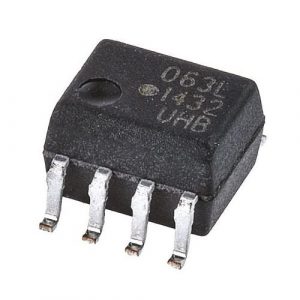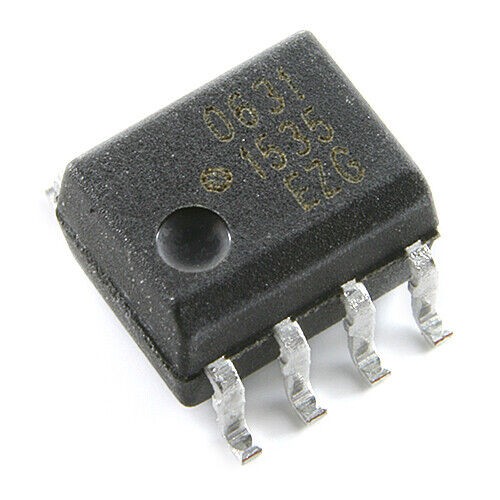HCPL-063L
Part Number: HCPL-063L
Manufacturer: Broadcom / Avago
Description: High Speed Optocouplers
Shipped from: Shenzhen/HK Warehouse
Stock Available: Check with us
ICRFQ.com - Electronic Components Distributor in China Since 2003

Part Number: HCPL-063L
Manufacturer: Broadcom / Avago
Description: High Speed Optocouplers
Shipped from: Shenzhen/HK Warehouse
Stock Available: Check with us
| Datasheet | |
|---|---|
| Category | Isolators |
| Family | Optoisolators – Logic Output |
| Manufacturer | Broadcom Limited |
| Series | – |
| Packaging | Tube |
| Part Status | Active |
| Number of Channels | 2 |
| Inputs – Side 1/Side 2 | 2/0 |
| Voltage – Isolation | 3750Vrms |
| Common Mode Transient Immunity (Min) | 10kV/μs |
| Input Type | DC |
| Output Type | Open Collector, Schottky Clamped |
| Current – Output / Channel | 50mA |
| Data Rate | 15MBd |
| Propagation Delay tpLH / tpHL (Max) | 75ns, 75ns |
| Rise / Fall Time (Typ) | 24ns, 10ns |
| Voltage – Forward (Vf) (Typ) | 1.5V |
| Current – DC Forward (If) (Max) | 15mA |
| Voltage – Supply | 2.7 V ~ 3.6 V, 4.5 V ~ 5.5 V |
| Operating Temperature | -40°C ~ 85°C |
| Mounting Type | Surface Mount |
| Package / Case | 8-SOIC (0.154″, 3.90mm Width) |
| Supplier Device Package | 8-SO |
Combining a GaAsP light emitting diode and a high gain photodetector into a single device, the HCPL 063L are optically connected gates. A detector that can be strobed by an enable input. The detector IC has a Schottky-clamped open collector transistor as its output. For common mode transient immunity, the internal shield promises 15 kV/s.
The high AC/DC isolation and LVTTL/LVCMOS compatibility make this design stand out. Optocouplers have a temperature range of -40 to +85 degrees Celsius, where their AC and DC working parameters are ensured. The high ground and induced noise situations for which these optocouplers are most suited include high-speed logic interfacing, input/output buffering, and line receiver applications. First, let’s define a digital optocoupler before learning more about the device in this article.
A semiconductor device that enables the transmission of an electrical signal between two separate circuits is known as an optocoupler. This type of device is also known as an optoisolator. An optocoupler consists of two components: a light-emitting diode (LED) that produces infrared light and a photosensitive device that detects light produced by the LED. Both components are housed inside a black box with pins for connectivity. The LED is activated by the input circuit, independent of whether the incoming signal is AC or DC and makes use of the signal in any case.
The part of the output circuit responsible for detecting light is called the photosensor, and the type of output circuit determines whether the output is AC or DC. First, a current is passed through the optocoupler, which causes the LED to release an infrared light at a rate proportionate to the current passing through the device. When light shines on the photosensor, a current is conducted, and the device is turned on. If the current flow through the LED is suddenly stopped, the IR beam will be extinguished, which will cause the photosensor to lose its ability to conduct electricity.
Optocouplers can be assembled in one of four distinct configurations, each distinguished by the photosensitive component it employs. In DC circuits, photo-transistors and photodarlingtons are generally used, while phototriacs and photo semiconductors are utilized in managing AC circuits. The photo-transistor optocoupler had a transistor that could be either PNP or NPN, depending on the application. The Darlington transistor consists of a pair of transistors, each of which can independently control the base of the other transistor in the pair. The Darlington transistor can gain a lot of voltage.
There is a distinction, albeit a subtle one, between an optocoupler and an optoisolator, despite the fact that these terms are frequently used interchangeably. The distinguishing feature of this component is the predicted voltage difference between the input and the output. Optocouplers transport analog or digital information between circuits while maintaining electrical isolation at potentials as high as 5,000 volts. This can be accomplished with the help of an optoisolator. When the potential difference between two circuits is more than 5,000 volts, an optoisolator is required to ensure the safe transmission of analog or digital information.
The HCPL-063L digital optocoupler has a GaAsP LED and a high-gain photodetector. A strobe signal can be sent to the detector using an enabled input. A Schottky-clamped n open collector transistor is what comes out of the detector integrated circuit as its output. Due to the presence of the internal shield, a standard mode transient immunity specification of 15 kV/ms is guaranteed.
In addition to being compatible with LVTTL and LVCMOS, this one-of-a-kind design achieves the highest possible AC and DC circuit isolation. The optocoupler’s AC and DC operational parameters are guaranteed to be stable from -40 degrees Celsius to 85 degrees Celsius, enabling trouble-free system performance.
It is recommended for usage in highly high-ground or induced noise situations. It is suitable for high-speed logic interfacing, input/output buffering, and line receivers in circumstances that conventional line receivers cannot withstand. It can also be applied to high-speed logic interfacing. It is offered in both the industry-standard 8-pin DIP and SO-8 packages.

The HCPL-063L is a high-speed optically connected Logic Gate Optocoupler which puts together a light emitting GaAsP diode with a photodetector which is integrated high gain. It has a surface-mount configuration with eight pins and two channels. An open collector Schottky-clamped transistor is the output of the integrated detector circuit.
The internal shield does provide a typical specification of 15 kV/ms transient immunity mode. This is a guaranteed specification.
This one-of-a-kind design achieves LVTTL/LVCMOS compatibility while offering the highest level of AC and DC circuit isolation possible. DC operational and Optocoupler AC is characterised by a 40 to 85 degrees Celsius, providing trouble-free system performance over that temperature range. It is appropriate for high-speed type of logic interfacing and output/input buffering as line receivers in situations that traditional line receivers cannot withstand. It is recommended for use in extremely high ground or generated noise environments.
We sincerely hope this article has supplied you with the most up-to-date and helpful information regarding the product discussed earlier, including its capabilities, how it operates, and the various uses for which it may be used. If you have any further inquiries concerning this article or other content on our website, please do not hesitate to submit them in the comment sections below. We will do our very best to respond to them.
For more details or purchase of HCPL-063L, contact us at ICRFQ. We are the best distributors of electronic components in China.
WhatsApp us